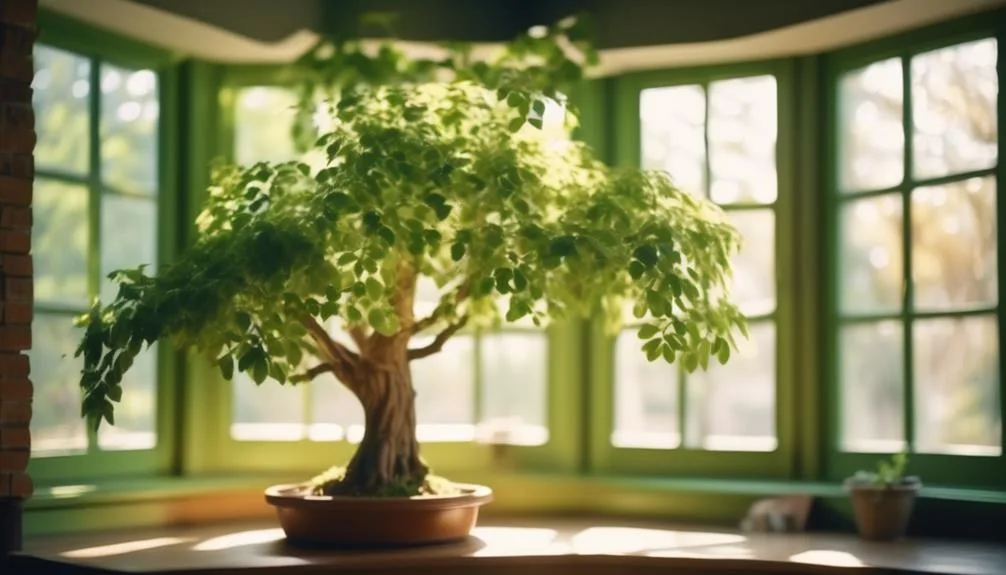Thinking about having an elm tree in your home? It's doable with the right info and care.
From choosing the best elm variety to understanding indoor conditions, there's a lot to consider.
Whether you're a seasoned indoor gardener or just starting out, the idea of nurturing an elm tree indoors is both fascinating and fulfilling.
Suitable Elm Tree Varieties for Indoor Growth
When choosing elm tree varieties for indoor growth, it's important to select species that are well-suited to the conditions inside your home. Consider the lighting requirements for different types of elm trees.
Some varieties, like the Chinese Elm, thrive in bright, indirect light, while others, like the Lacebark Elm, can tolerate lower light conditions.
Additionally, temperature control is crucial for the health of indoor elm trees. Most varieties prefer cool to moderate temperatures, ideally between 60-70°F during the day and slightly cooler at night. Keep in mind that sudden temperature fluctuations can stress the tree, so try to maintain a consistent environment.
Indoor Conditions for Growing Elm Trees
To successfully cultivate elm trees indoors, it's essential to create an environment that meets their specific lighting and temperature needs, ensuring they thrive and enhance your indoor space with their natural beauty.
Indoor Conditions for Growing Elm Trees
- Lighting Requirements: Elm trees thrive in bright, indirect light. Consider placing them near a south- or west-facing window to ensure they receive ample sunlight. If natural light is insufficient, supplement with grow lights to provide the necessary intensity.
- Temperature Control: Maintain a consistent indoor temperature between 60-70°F (15-21°C) during the day and slightly cooler at night. Avoid placing elm trees near drafts or heating/cooling vents to prevent temperature fluctuations.
Selecting the Right Container for Indoor Elm Trees
Wondering what type of container is best for growing elm trees indoors? When it comes to selecting the right pot for your indoor elm tree, it's crucial to prioritize proper drainage. Choose a container with drainage holes to prevent waterlogged soil, which can lead to root rot. Opt for a pot that's at least 10-12 inches in diameter to provide ample space for the tree's roots to grow.
Additionally, ensure the pot is made of a lightweight material, such as plastic or fiberglass, to make it easier to move as needed. For optimal growth, place the container in a well-lit area, as elm trees thrive in bright, indirect light. Maintain a consistent room temperature of around 60-70°F for the best results.
With the right container and conditions, you can successfully grow an elm tree indoors.
Watering and Fertilizing Indoor Elm Trees
For optimal growth and health of your indoor elm tree, it's essential to understand the proper watering and fertilizing techniques. Here are some key points to keep in mind:
- Soil Composition: Use well-draining soil with a mix of peat moss, perlite, and pine bark to ensure adequate moisture retention without waterlogging the roots.
- Watering: Water your indoor elm tree when the top inch of the soil feels dry, ensuring that excess water can freely drain from the container. Avoid overwatering, as it can lead to root rot.
- Fertilizing: During the growing season, use a balanced liquid fertilizer every 4-6 weeks to provide essential nutrients. Reduce the frequency to every 8-12 weeks in the winter when growth slows down.
Remember to place your elm tree in a spot with ample natural light to support its growth.
Following these guidelines will help your indoor elm tree thrive.
Maintaining and Pruning Indoor Elm Trees
When maintaining and pruning your indoor elm tree, regularly inspect the branches for dead or diseased wood and promptly remove them to promote healthy growth and prevent potential issues. Use clean, sharp pruning shears to make precise cuts, ensuring the wounds can heal properly.
When pruning, focus on removing any crossing or rubbing branches to maintain an open and balanced canopy. Additionally, consider using a diluted neem oil solution to control common indoor pests such as aphids or spider mites.
Pruning techniques such as thinning out crowded growth and shaping the tree's structure can help improve airflow and reduce the risk of pest infestations.
Conclusion
Incorporating the right variety, proper indoor conditions, and attentive care, growing elm trees indoors is indeed achievable. Select a suitable variety, maintain indoor conditions, choose an appropriate container, and provide regular watering and fertilization.
By tending to your indoor elm tree, you can bring the beauty of nature into your home. Happy growing!

My interest in trees started when I first saw the giant sequoias in Yosemite.
I was a teenager then, and I remember thinking, “I need to learn more about this.”
That moment stuck with me.
A few years later, I went on to study forestry at Michigan Tech.
Since graduating, I’ve worked in a mix of hands-on tree care and community education.
I’ve spent over ten years helping people understand how to plant, maintain, and protect the trees in their neighborhoods.
I don’t see trees as just part of the landscape.
They are living things that make a real difference in our daily lives.
